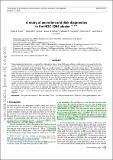A study of accretion and disk diagnostics in the NGC 2264 cluster
Abstract
Context. Understanding disk dissipation is essential for studying how planets form. Disk gaps and holes, which almost correspond to dust-free regions, are inferred from infrared observations of T Tauri stars (TTS), indicating the existence of a transitional phase between thick accreting disks and debris disks. Transition disks are usually referred to as candidates for newly formed planets. Aims. We searched for transition disk candidates belonging to NGC 2264. Using stellar and disk parameters obtained in the observational multiwavelength campaign CSI 2264, we characterized accretion, disk, and stellar properties of transition disk candidates and compared them to systems with a full disk and diskless stars. Methods. We modeled the spectral energy distribution (SED) of a sample of 401 TTS, observed with both CFHT equipped with MegaCam and IRAC instrument on the Spitzer, with Hyperion SED fitting code using photometric data from the U band (0.3 μm) to the Spitzer/MIPS 24 μm band. We used the SED modeling to distinguish transition disk candidates, full disk systems, and diskless stars. Results. We classified ∼52% of the sample as full disk systems, ∼41% as diskless stars, and ∼7% of the systems as transition disk candidates, among which seven systems are new transition disk candidates belonging to the NGC 2264 cluster. The sample of transition disk candidates present dust in the inner disk similar to anemic disks, according to the αIRAC classification, which shows that anemic disk systems can be candidate transition disks. We show that the presence of a dust hole in the inner disk does not stop the accretion process since 82% of transition disk candidates accrete and show Hα, UV excess, and mass accretion rates at the same level as full disk systems. We estimate the inner hole sizes, ranging from 0.1 to 78 AU, for the sample of transition disk candidates. In only ∼18% of the transition disk candidates, the hole size could be explained by X-ray photoevaporation from stellar radiation.
Citation
Sousa , A P , Alencar , S H P , Rebull , L M , Espaillat , C C , Calvet , N & Teixeira , P S 2019 , ' A study of accretion and disk diagnostics in the NGC 2264 cluster ' , Astronomy & Astrophysics , vol. 629 , A67 . https://doi.org/10.1051/0004-6361/201935563
Publication
Astronomy & Astrophysics
Status
Peer reviewed
ISSN
0004-6361Type
Journal article
Collections
Items in the St Andrews Research Repository are protected by copyright, with all rights reserved, unless otherwise indicated.

